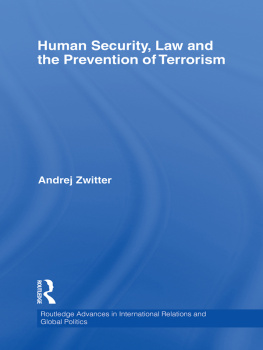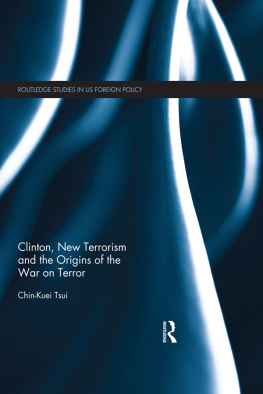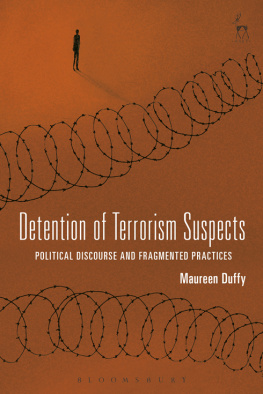iv Published by Rowman & Littlefield International Ltd
Unit A, Whitacre Mews, 26-34 Stannary Street, London SE11 4AB
www.rowmaninternational.com
Rowman & Littlefield International Ltd.is an affiliate of Rowman & Littlefield
4501 Forbes Boulevard, Suite 200, Lanham, Maryland 20706, USA
With additional offices in Boulder, New York, Toronto (Canada), and Plymouth (UK)
www.rowman.com
Copyright 2018 by Phil Gurski
All rights reserved . No part of this book may be reproduced in any form or by any electronic or mechanical means, including information storage and retrieval systems, without written permission from the publisher, except by a reviewer who may quote passages in a review.
British Library Cataloguing in Publication Data
A catalogue record for this book is available from the British Library
ISBN: HB 978-1-7866-0953-3
PB 978-1-7866-0954-0
Library of Congress Cataloging-in-Publication Data
Names: Gurski, Phil, author.
Title: An end to the war on terrorism / Phil Gurski.
Description: Lanham : Rowman & Littlefield International, [2018] | Includes bibliographical references and index.
Identifiers: LCCN 2018021803 (print) | LCCN 2018025400 (ebook) | ISBN 9781786609557 (Electronic) | ISBN 9781786609533 (cloth : alk. paper) | ISBN 9781786609540 (pbk. : alk. paper)
Subjects: LCSH: Terrorism. | TerrorismPrevention. | TerrorismReligious aspectsIslam.
Classification: LCC HV6431 (ebook) | LCC HV6431 .G877 2018 (print) | DDC 363.325dc23
LC record available at https://lccn.loc.gov/2018021803

The paper used in this publication meets the minimum requirements of American National Standard for Information SciencesPermanence of Paper for Printed Library Materials, ANSI/NISO Z39.48-1992.
Printed in the United States of America
v To Angus, my old friend and mentor from whom I have learned more than he realizes
ix Preface
We like our battles to have a beginning and an end, to mark a moment and leave a meaning that posterity can grasp and visitors can celebrateusually, a symbolic or strategic turning point, when one side loses the initiative and never regains it, as at Gettysburg or Stalingrad.
Paul Jankowski, What Was the Point of Verdun?
Time is passing. Yet, for the United States of America, there will be no forgetting September the 11th. We will remember every rescuer who died in honor. We will remember every family that lives in grief. We will remember the fire and ash, the last phone calls, the funerals of the children.
September 11, 2001, was a Tuesday. And a glorious Tuesday it was, the time between late summer and early fall in eastern Canada. If memory serves me correctly, it was sunnyblue skies and a temperature in the 50s in the morning.
I had walked to my job at the Canadian Security Intelligence Service (CSIS) as was my usual practice. Thirty minutes to work, thirty minutes home, a daily routine that I had come to regard as precious since I started nine months earlier in a much different January climate. I had come to CSIS after spending almost eighteen years at Communications Security Establishment (CSE), Canadas signals intelligence agency, and cant say that I missed the almost one-hour commute by bus to the office each day.
After my usual workout at the CSIS gym, I settled into my daily tasks: checking email and seeing what had happened in Canada and internationally overnight to see what I might be asked to think or write about that day. I had come to the Service, as everyone calls CSIS around town, as a x secondee, a temp worker as it were, although I later resigned from CSE and joined CSIS full time six months after that sunny September day. During my years at CSE I had developed into a multilingual analyst with a specialization in the Middle East thanks to my proficiency in Arabic and Farsi (though my skills in both are now woefully rusty), and I had negotiated a shift to CSIS for a change. The Service needed a strategic analyst on Iran, and in light of my fifteen years of experience on that nation, I was brought into the analysis branch. For good measure, my superiors had me keep an eye on the Middle East in general as it related to the CSIS mandate (i.e., threats to the security of Canada).
I wrote above that September 11 dawned a glorious day, but that of course is a terrible description for what ensued in New York City; Washington, DC; and Shanksville, Pennsylvania, that fateful morning. As I began my morning scanning, as I called it, someone came to my office to say that a plane had just flown into one of the World Trade Center towers in New York.
It is not my intention to lie to you here and say that I had a blinding flash of realization. I was not following terrorist intent at that time, and while I had written a paper on the links between Al Qaeda and the USS Cole bombing in late 2000 (just prior to my arrival at CSIS), I was anything but a terrorism expert, although I do remember a SIGINT (signals intelligence) reporting line I used to check on what was then called the UBL [Usama bin Laden] Network. In fact, my first reaction to the news was to dismiss it as yet another unfortunate incident of pilot error as there recently had been other such accidents that were just that: accidents. These had nothing to do with terrorism, let alone Al Qaeda. So no, my analytic mind did not leap to the 1992 World Trade Center bombing, which was an Al Qaeda operation and a preview of what would happen on 9/11. I had no Aha! moment. I didnt even know where in Manhattan the World Trade Center was, never having visited New York (that has since been rectified, much to my delight).
As I and others gathered around a TV screen in a common room wondering what the hell was happening, we watched as a second plane hit the other tower (the south one). I stood aghast, and what I was witnessing was starting to sink in. This was no Cessna with a clueless pilot or a tragic accident. It was a full-size airliner. This was intentional. While it could have been a particularly horrendous coincidence, that was highly unlikely. This was terrorism.
The next few days were a blur. I was immediately called back to CSE to work one of many around-the-clock shifts to contribute what we could to help understand what had happened and determine if this was merely the start of more mass casualty acts. My new colleagues at CSIS spent weeks turning over every stone to see whether there was any link to Canada, however tenuous. After all, had the terrorists had any tie to Canada, it would have led to searing questions as to what our security services were doing (or better xi yet not doing) and seriously complicated bilateral relations with the United States. It turned out that there were no links, although that has not stopped some officials in the United States, including former secretary of state Hillary Rodham Clinton, from erroneously stating publicly that some of the hijackers came from my country.
And yet 9/11 was a glorious day in a different wayfrom the perspective of the terrorists. It is not a coincidence that the hijackers of those four aircraft are called the Magnificent 19. Al Qaeda had just pulled off an incredible act of violence the likes of which we may never see again. They had successfully planned and executed an operation in the heart of the United States, the head of the snake as they called it, killing more than three thousand people and striking a blow at the worlds dominant economic, military, and political power. Hence the symbolism of the attacks: the World Trade Center (economic), the Pentagon (military), and, though prevented, the White House (political; the plane targeting the White House crashed prematurely in Pennsylvania when the passengers rushed the hijackers).












 The paper used in this publication meets the minimum requirements of American National Standard for Information SciencesPermanence of Paper for Printed Library Materials, ANSI/NISO Z39.48-1992.
The paper used in this publication meets the minimum requirements of American National Standard for Information SciencesPermanence of Paper for Printed Library Materials, ANSI/NISO Z39.48-1992.